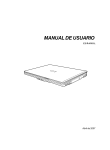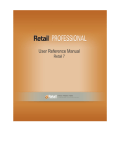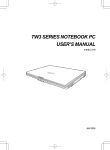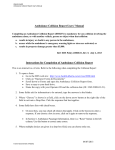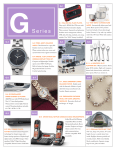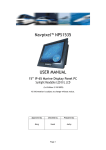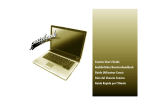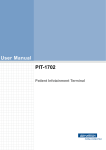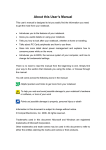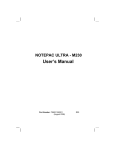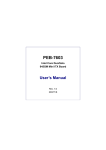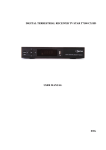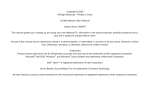Download USER`S MANUAL - Airis Support
Transcript
USER’S MANUAL ENGLISH April 2007 CONTENTS BEFORE YOU START ............................................................................................. 5 Make sure you have everything ..................................................................................... 5 Familiarize yourself with the computer ........................................................................ 6 OPENING THE DISPLAY PANEL ................................................................................ 6 FRONT OVERVIEW .................................................................................................... 7 LEFT SIDE OVERVIEW .............................................................................................. 9 RIGHT SIDE OVERVIEW .......................................................................................... 11 BACK OVERVIEW ..................................................................................................... 12 BOTTOM OVERVIEW ................................................................................................ 12 GETTING STARTED ............................................................................................. 13 Power Sources ............................................................................................................. 13 CONNECTING THE POWER ADAPTERS ............................................................... 13 RECHARGING THE BATTERY ................................................................................. 14 Starting Your Notebook ................................................................................................. 15 POWER ON .............................................................................................................. 15 Status Indicators ...................................................................................................... 16 Using Function Keys ................................................................................................ 18 Using the TouchPad ................................................................................................. 19 Memory Module Upgrade ......................................................................................... 20 TROUBLESHOOTING ........................................................................................... 21 Identifying the Problem ................................................................................................. 21 APPENDIX ............................................................................................................ 22 Notebook Specifications .............................................................................................. 22 2 TAKING CARE OF YOUR NOTEBOOK PC To prevent possible overheating of the computer's processor, make sure you don't block the openings provided for ventilation. DO NOT press or touch the display panel. DO NOT place on uneven or unstable work surfaces. DO NOT use your notebook computer under harsh conditions. DO NOT place or drop objects on the computer and DO NOT apply heavy pressure on it. DO NOT subject the computer to magnetic fields. DO NOT expose to direct sunlight. DO NOT use or store in extreme temperatures. 3 Avoid sudden changes in temperature or humidity by keeping it away fromA/C and heating vents. DO NOT expose the computer to rain or moisture. DO NOT place near fire or other sources of heat. DO NOT tamper with the batteries. Keep them away from children. DO NOT expose to dust and/or corrosive chemicals. DO NOT slam your notebook shut and never pick up or hold your notebook by the display. DO NOT spray water or any other cleaning fluids directly on the display. If you are traveling with your computer, remember to carry it as hand luggage. Do not check it in as baggage. 4 BEFORE YOU START Make sure you have everything When you receive your notebook PC, unpack it carefully, and check to make sure you have all the items listed below. For a pre-configured model you should have the following: • Notebook Computer • Lithium-Ion battery • AC adapter with power cord • Driver and Applications CD • Quick Start Guide or User Guide Depending upon the configuration of your notebook, you may also need following items: • DVD / CD-RW Combo Application CD • Dual DVD+/-RW Application CD • Super Multi DVD RW Application CD Once you have checked and confirmed that your notebook system is complete, read through the following pages to learn about all of your notebook components. 5 BEFORE YOU START Familiarize yourself with the computer OPENING THE DISPLAY PANEL To open, slide the latch and then simply lift the lid up. When closing it, be sure not to slam it shut. 1 2 6 BEFORE YOU START FRONT OVERVIEW The following is an overview of the front of the notebook. Camera Wireless LAN Display Panel Quick Start Buttons Suspend/ Power On Button Keyboard TouchPad Pointing Device Status Indicator Lights Headphone Jack Line-In Jack IEEE 1394 Port Microphone Jack Camera The built-in 1.3 Mega pixel camera allows you to snap a photo or create a video chat or video conference within just a click. (This feature depends on your configuration.) Display Panel The display panel is a color LCD panel with back lighting for the display of text and graphics. Keyboard A full-size keyboard with dedicated Windows® keys. Status Indicator Lights The Status indicator lights correspond to specific operating modes. These modes are: Caps lock, Num Lock, Hard drive Activity (HDD), Wireless Activity, Power on/Suspend status, Battery/ AC Adapter status, and Media reader Activity. IEEE 1394 Port The 1394 port is used to connect between your and a peripheral such as a digital video camera. 7 BEFORE YOU START Microphone Jack The microphone jack allows you to connect an external mono microphone. Line-In Jack The line-in jack allows you to connect external audio recording and playback devices. Headphone Jack The headphone jack allows you to connect headphones or external speakers and amplifiers. TouchPad Pointing Device The TouchPad pointing device is a mouse-like cursor control with two buttons and a touch sensitive movement pad. Suspend/Power On Button This button turns your notebook on and off as well as puts it to sleep. (See Suspend/Power On Button in the Power On section for more information.) Quick Start Buttons The six quick start buttons allow you to launch your favorite Wireless network, Internet and Email applications with the press of a button. You can also engage the computer's Silent and Mute modes by press Silence and Mute button. Wireless LAN The Wireless LAN button enables and disables Wireless LAN activity. Array Microphone The built-in array microphone is an omni-directional audio input device. It allows for the stereo reception and transmission of voice and/or other audio data to any program capable of accepting such input. Stereo Speakers The built-in dual speakers allow for stereo sound. 8 BEFORE YOU START LEFT SIDE OVERVIEW The following is a brief description of the left side of the notebook. Port Replicator Interface External Monitor/DVI Port USB Ports Power Adapter Port LAN (RJ-45) Port S-Video/TV Out Port Power Adapter Port The power adapter port allows you to plug in the AC adapter to power your notebook and charge the internal Lithium-Ion battery. Port Replicator Interface The Port Replicator Interface allows you to connect additional peripheral devices to your computer through a "universal" port, as it were. The Port Replicator itself contains all the necessary additional ports, and connects to your computer through a single port on the left side of the computer. (Not available in all configurations.) LAN (RJ-45) Port The LAN port is designed to support a 10/100 or 10/100/1000(option) Base-TX standard RJ-45 plug. Depending on your configuration: External Monitor Port The external monitor port allows you to connect an external monitor. Or DVI Port The DVI port allows you to connect an external monitor or television to the computer using a Digital Video Interface cable. 9 BEFORE YOU START S-Video/TV Out Port The S-video/TV out port allows you to connect to video devices such as, a television, projector, or a VCR, to your computer. USB Ports The USB ports allow you to connect Universal Serial Bus devices. They support v2.0 of the USB standard, which allows data exchange rates as high as 480 Mb/s. 10 BEFORE YOU START RIGHT SIDE OVERVIEW The following is a brief description of the right side of the notebook. PC Express Card Slot Optical Drive Activity Indicator Memory Card Reader USB Port Optical Drive Optical Drive Eject Button Emergency Tray Release Modem (RJ-11) Port Kensington Lock Slot USB Port PC Express Card Slot The PC Card Slot allows you to install one Type-II PC Express Card. Memory Card Reader The memory card reader offers the fastest and most convenient method to transfer pictures, music and data between your notebook and flash compatible devices such as digital cameras, MP3 players, mobile phones, and PDAs. USB Ports The USB ports allow you to connect Universal Serial Bus devices. They support v2.0 of the USB standard, which allows data exchange rates as high as 480 Mb/s. Optical Drive The Optical Drive allows you to play back a media discs, such as CDs and DVDs. Optical Drive Activity Indicator This light flickers to indicate activity when the ODD is playing a media disc or is being accessed by the operating system. Optical Drive Eject Button The Optical Drive Eject Button allows you to open the Optical Drive tray to remove or insert a DVD or CD. Emergency Tray Release The Emergency Tray Release allows you to open the Optical Drive tray without powering on your notebook. Modem (RJ-11) Port The modem (RJ-11) port is used to attach a telephone line to the internal 56K modem. Kensington Lock Slot The Kensington lock slot allows you to secure your notebook to an immovable object through an optional security cable. 11 BEFORE YOU START BACK OVERVIEW The following is an overview of the back of the notebook. BOTTOM OVERVIEW The following is an overview of the bottom of the notebook. Lithium-Ion Battery Bay Fan Outlets Rating Label Compartment Cover Lithium-Ion Battery Bay The battery bay contains the internal Lithium-Ion battery. It can be opened for the removal of the battery when stored over a long period of time or for swapping a discharged battery with a charged Lithium-Ion battery. Rating Label The label shows the model number and other information about your notebook. Compartment Cover The Wireless LAN compartment contains the Wireless LAN card. The memory compartment contains the computer's memory modules. The internal hard disk drive is accessible through the hard disk drive bay. The CPU sits in the CPU bay. Fan Outlets These are open ports for the fan to dissipate heat from the computer's internal components. Do not block or place the computer in such a position that you inadvertently allow the outlets to become blocked. 12 GETTING STARTED Power Sources Your computer has two types of power source: a Lithium-Ion battery or an AC adapter. CONNECTING THE POWER ADAPTERS The AC adapter provides power for operating your notebook PC and charging the battery. Connecting the AC Adapter 1. Plug the DC output cable into the DC power jack of your notebook PC. 2. Plug the AC adapter into an AC electrical outlet. Switching from AC Adapter Power to Battery Power 1. Be sure that you have at least one charged battery installed. 2. Remove the AC adapter. Your notebook will automatically switch from DC power to battery power. NOTE The Lithium-Ion battery is not charged upon purchase. Initially, you will need to connect the AC adapter to use your notebook PC. 13 GETTING STARTED RECHARGING THE BATTERY The Lithium-Ion battery is recharged internally using the AC adapter. To recharge the battery, make sure the battery is installed and the computer is connected to the AC. There is no "memory effect" in Lithium-Ion batteries; therefore you do not need to discharge the battery completely before recharging. The charge times will be significantly longer if your notebook PC is in use while the battery is charging. If you want to charge the battery more quickly, put your computer into Suspend mode, or turn it off while the adapter is charging the battery. Low Battery State When the battery charge is low, a notification message appears. If you do not respond to the low battery message, the battery continues to discharge until it is too low to operate. When this happens, your notebook PC goes into Suspend mode. There is no guarantee your data will be saved once the notebook reaches this point. CAUTION To protect your computer from damage, use only the power adapter that came with it because each power adapter has its own power output rating. Once your note computer goes into Suspend mode as a result of a dead battery you will be unable to resume operation until you provide a source of power either from an adapter, or a charged battery. Once you have provided power, you can press the Suspend/ Resume button to resume operation. In Suspend mode, your data is maintained for some time, but if a power source is not provided promptly, the Power indicator stops flashing and the goes out, in which case you have lost the data that was not saved. Once you provide power, you can continue to use your computer while an adapter charges the battery. 14 GETTING STARTED Starting Your Notebook POWER ON Suspend/Power On Button The suspend/power on switch is used to turn on your notebook from its off state. Once you have connected your AC adapter or charged the internal Lithium-Ion battery, you can power on your notebook by pressing the suspend/power on button located above the keyboard. If you need to take an extended break, press the button again to turn it off. CAUTION Do not carry your notebook around with the power on or subject it to shocks or vibration, as you risk damaging the hard disk. When you power on your notebook, it will perform a Power On Self Test (POST) to check the internal parts and configuration for correct functionality. If a fault is found, your computer emits an audio warning and or displays and error message. Depending on the nature of the problem, you may be able to continue by starting the operating system or by entering the BIOS setup utility and revising the settings. After satisfactory completion of the Power On Self Test (POST), your notebook loads the installed operating system. CAUTION Never turn off your notebook during the Power On Self Test (POST), or an unrecoverable error may occur. 15 GETTING STARTED Status Indicators The Status indicator lights correspond to specific operating modes. These modes are: Caps Lock, Num Lock, Power On/Suspend Status; Battery/AC Adapter status; Media reader Activity; and Wireless LAN Activity. Furthermore, at the top of the keyboard there are six additional status indicator lights: Power button, Internet, E-mail, Mute, Silence mode, and Wireless. Caps Lock Indicator Num Lock Indicator HDD Activity Indicator Light sensor WLAN A Power On Indicator/ Suspend Status Indicator 1 Battery Internet E-mail Silence Mute Wireless LAN Activity Indicator Media Card Status Indicator The Caps Lock Indicator This indicator tells you that the keyboard is set to type in all capital letters. The Num Lock Indicator This indicator states that the internal keyboard is set in ten-key numeric keypad mode. Hard Disk Drive (HDD) Activity Indicator The Hard Disk Drive (HDD) Activity indicator tells you whether your internal hard drive is being accessed and, if so, how fast. 16 GETTING STARTED Power On Indicator This light on the power button illuminates when the computer is powered on. Suspend Status Indicator This light flashes when the computer is in the Suspend mode. Battery Indicator The Battery indicator light tells you whether the Lithium-Ion battery is charging or is already fully charged. • If you are charging your battery, the Battery indicator lights remains on even if your notebook is shut off. • If there is no battery activity, the power adapters are not connected, or the power switch is Off, the Battery indicator will also be off. • Batteries subjected to shocks, vibrations or extreme temperatures can be permanently damaged. Wireless LAN Activity Indicator The Wireless LAN Activity indicator tells you whether your computer is connected to a wireless network or not. Media Card Status Indicator This light flickers when the computer is reading a multimedia or SD card. 17 GETTING STARTED Using Function Keys Your computer has 12 function keys, F1 through F12. The functions assigned to these keys differ for each application. You should refer to your software documentation to find out how these keys are used. The [FN] key provides extended functions for the notebook and is always used in conjunction with another key. • [FN+F1]: Places the notebook in Suspend mode. Pressing the Power button returns it to active mode. • [FN+F2]: Enables or disables the wireless network connection. • [FN+F3]: Allows you to change your selection of where to send your display video. Each time you press the combination of keys you will step to the next choice. The choices, in order, are: built-in display panel only, both built-in display panel and external monitor, or external monitor only. • [FN+F4]: Decreases the screen Brightness. • [FN+F5]: Increases the screen Brightness. • [FN+F6]: Mutes the computer's volume. • [FN+F7]: Decreases the computer's volume. • [FN+F8]: Increases the computer's volume. • [FN+F9]: Plays or pauses the current multimedia track. • [FN+F10]: Stops the current multimedia track. • [FN+F11]: Goes to the previous multimedia track. • [FN+F12]: Goes to the next multimedia track. • [FN+Esc]: Enables or disables the Bluetooth function. • [FN+Home]: When Num Lock is enabled, press [FN+Home] to enables or disable the Light Sensor function. 18 GETTING STARTED Using the TouchPad A TouchPad pointing device comes built into your computer. It is used to control the movement of the pointer to select items on your display panel. The TouchPad consists of a cursor control, a left and right button, and two scroll buttons. The cursor control works the same way a mouse does, and moves the cursor around the display. It only requires light pressure from the tip of your finger. The left and right buttons function the same as mouse buttons. The actual functionality of the buttons may vary depending on the application that is being used. Finally, the scroll buttons allow you to navigate quickly through pages, without having to use the on-screen cursor to manipulate the up and down scroll bars. Clicking Clicking means pushing and releasing a button. To left-click, move the cursor to the item you wish to select, press the left button once, and then immediately release it. To right click, move the mouse cursor to the item you wish to select, press the right button once, and then immediately release it. You also have the option to perform the clicking operation by tapping lightly on the TouchPad once. Double-Clicking Double-clicking means pushing and releasing the left button twice in rapid succession. This procedure does not function with the right button. To double-click, move the cursor to the item you wish to select, press the left button twice, and then immediately release it. You also have the option to perform the double-click operation by tapping lightly on the TouchPad twice. Dragging Dragging means pressing and holding the left button, while moving the cursor. To drag, move the cursor to the item you wish to move. Press and hold the left button while moving the item to its new location and then release it. Dragging can also be done using the TouchPad. First, tap the TouchPad twice over the item you wish to move making sure to leave your finger on the pad after the final tap. Next, move the object to its new location by moving your finger across the TouchPad, and then release your finger. Using the Scroll buttons allows you to navigate through a document quickly without using the window's scroll bars. This is particularly useful when you are navigating through on-line pages. 19 ENGLISH GETTING STARTED Memory Module Upgrade Your notebook PC comes with either 512MB of high speed Synchronous Dynamic RAM (SDRAM) factory installed. To increase your notebook's memory capacity (up to 4GB maximum), you may install an additional memory upgrade module. The memory upgrade must be a dual-inline (DIMM) SDRAM module. Do not remove any screws from the memory upgrade module compartment except for the ones specifically shown in the directions here. Installing a Memory Module To install a memory upgrade module follow these steps: 1. Turn off power to your notebook using the power switch, disconnect the power adapter, and/ or remove the battery pack. 2. Place your notebook upside-down on a clean work surface. 3. Open the top cover all the way, so that it is lying flat on the work surface. 4. Remove the five screws securing the compartment cover. The memory upgrade module can be severely damaged by electrostatic discharge (ESD). Be sure you are properly grounded when handling and installing the module. 5. Align the connector edge of the memory upgrade module, chip side up, with the connector slot in the compartment. 6. Insert the memory upgrade module at a 45o angle and press it firmly onto the connector. 7. Press the memory upgrade module down into the compartment until it locks into the retaining clips on either side. You will hear a click when it is properly in place. 8. Replace the cover and screws that were removed previously. Installation of the new memory module is now complete. The memory upgrade module is not something you routinely remove from your notebook PC. Once it is installed, you should leave it in place unless you want to increase system memory capacity. 20 TROUBLESHOOTING Your notebook PC is sturdy and subject to few problems in the field. However, you may encounter simple setup or operating problems that you can solve on the spot, or problems with peripheral devices, that you can solve by replacing the device. The information in this section helps you isolate and resolve some of these straightforward problems and identify failures that require service. Identifying the Problem If you encounter a problem, go through the following procedure before pursuing complex troubleshooting: 1. Turn off your notebook. 2. Make sure the AC adapter is plugged into your notebook and to an active AC power source. 3. Make sure that any card installed in the PC Card slot is seated properly. You can also remove the card from the slot, thus eliminating it as a possible cause of failure. 4. Make sure that any devices connected to the external connectors are plugged in properly. You can also disconnect such devices, thus eliminating them as possible causes of failure. 5. Turn on your notebook. Make sure it has been off at least 10 seconds before you turn it on. 6. Go through the boot sequence. 7. If the problem has not been resolved, contact your support representative. Before you place the call, you should have the following information ready so that the customer support representative can provide you with the fastest possible solution: • Product name • Product configuration number • Product serial number • Purchase date • Conditions under which the problem occurred • Any error messages that have occurred • Hardware configuration • Type of device connected, if any See the Configuration Label on the bottom of your notebook for configuration and serial numbers. 21 ENGLISH APPENDIX Notebook Specifications Processor (Merom) Intel® Centrino® Mobile Technology Intel Core 2 Duo Merom Processor T7300 ~T7700 (2.0GHz~2.4GHz, 800MHz, 2M/4M L2) Intel Core 2 Duo Merom Processor T7100 (1.8GHz, 800MHz, 2M L2) Intel Celeron M processor (Merom based) (Yonah 65nm, 533MHz, 1M L2) uFC-PGA Package 478 pins, Socket P 800MHz FSB BIOS 1M BB Flash ROM Chipset (Calistoga) Intel Crestline GM/PM + ICH8M Main Memory Zero on board and two SO-DIMM memory sockets 512MB to maximum 4GB 533/667MHz DDR2 SDRAM LCD Display 15.4" TFT-LCD WXGA, 1280x800, 16.7M colors Glare type support Graphics Intel Crestline GM Integrated graphics controller Intel® Graphics Media Accelerator (GMA) nVIDIA NB8M -128/256M (factory option) CRT Display Modes VGA 640x480, 256/64K/16.7M colors SVGA 800x600, 256/64K/16.7M colors XGA 1024x768, 256/64K/16.7M colors SXGA 1280x1024, 256/64K/16.7M colors Hard Disk Drive One 2.5" 9.5mm IDE HDD 5400 rpm with SATA 150 support Supported capacities of 40/60/80/100/120/160 GB Floppy Disk Drive N/A Optical Disk Drive One ODD Bay type 5.25"/12.7mm optical storage device(G-base), choices of 24/10/8/24X Combo CD-RW+DVD (factory option) 8/4/8X DVD+/-RW(factory option) 8/4/8/5X Super Multi DVD RW (factory option) Modem and Bluetooth 56K Modem 1.5, V.90/92 support Bluetooth : USB interface (Option) PC Cards Slot Express card support LAN & WLAN PCI-E Ethernet 10/100/1000 Base T on board Support dual band antenna Intel 4965 a/g/n (Mini card interface ) (Factory option) Intel 3945 a/b/g card (Factory option) Interface I/O Port 1 IEEE 1394 3 Audio jacks: Headphone-out, Mic-In, Line-in 1 CRT or DVI 4 USB ports (v2.0) 1 S-Video out 1 RJ11 connector for Modem 1 RJ45 connector for Ethernet 1 Port replicator port (Factory option) 1 1.3M Camera (Factory option) Audio Built-in High Definition Audio (2 channel) Built-in two stereo speakers Dual array Microphone Card Reader Support Memory Stick(MS-Pro), Multi Media Card, and Secure Digital(MS/MS PRO/MMC/SD) 22 Mini card System Status LED Button 2 Mini card slots for WLAN and Robson Power on/Suspend, Battery Charging, Wireless LAN, Caps Lock, Number Lock, HDD Access, Media reader 6 quick start buttons : Power button, Internet, Email, Mute, Silence mode, Wireless Keyboard 86(US)/87(EU)/90(JP)-key with Windows function keys Hot Keys on Keyboard Function Keys Fn+F1 Suspend switch Fn+F2 Wireless Enable/Disable Fn+F3 LCD/CRT/LCD+CRT Switch Fn+F4 Brightness down Fn+F5 Brightness up Fn+F6 Mute Fn+F7 Volume Down Fn+F8 Volume Up Fn+F9 Media Play/Pause Fn+F10 Media Stop Fn+F11 Media Play Backward Fn+F12 Media Play Forward Fn+ESC Blue tooth Enable/Disable Num Lk enable, Fn+Home light sensor Enable/ Disable Power Management Full feature ACPI power management, Stand-by, Suspend to Disk, Suspend to RAM ACPI 2.0 supported with Intel SpeedStep Light sensor Battery Pack & Life Li-Ion 6 cells,2200mAh/cell Li-Ion 6 cells,2400mAh/cell Li-Ion 9 cells,2400mAh/cell Battery life up to 3 hrs (estimate) AC adapter Output: 19V DC, 3.42A, 65W or 4.74A 90W (for Crestline PM) Input: 100~240V AC, 50/60Hz Universal Pointing Device Built-in touch pad with 2-way scroll function 2 click buttons Dimensions/Weight Dimensions :355(W)x254.5(D)x25.5~35.2 (H)mm Weight: ~2.7Kg (with 15.4"W TFT LCD, Combo Drive, 6-cells) Security Kensington lock hole OS & S/W Windows XP compliance Windows Vista compliance Copyright-protected technology This product incorporates copyright protection technology that is protected by U.S. patents and other intellectual property rights. Use of this copyright protection technology must be authorized by Macrovision, and is intended for home and other limited viewing uses only unless otherwise authorized by Macrovision. Reverse engineering or disassembly is prohibited. 23 MEMO
























